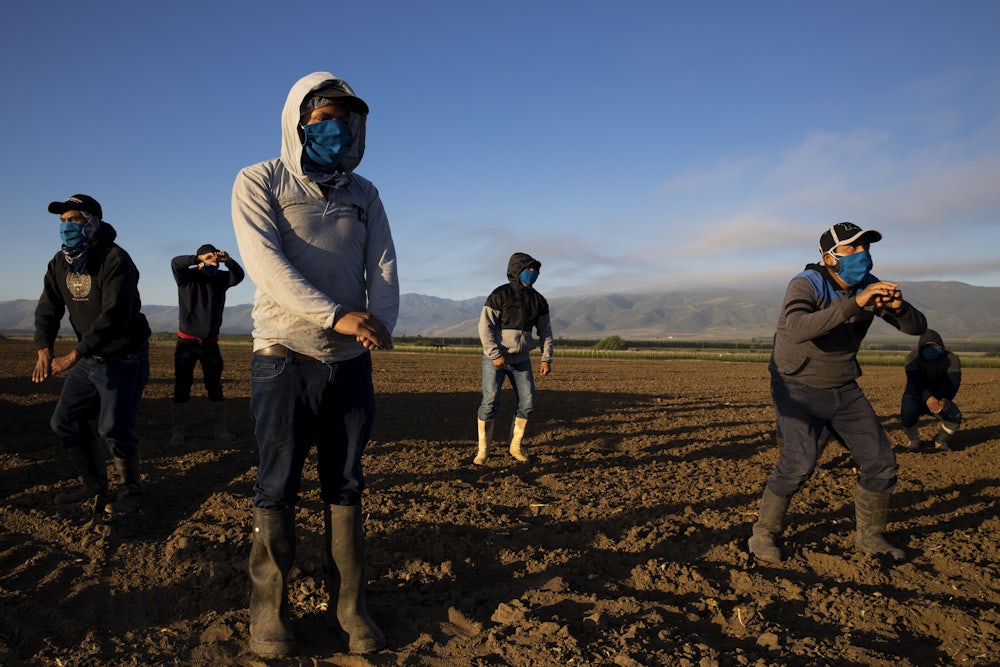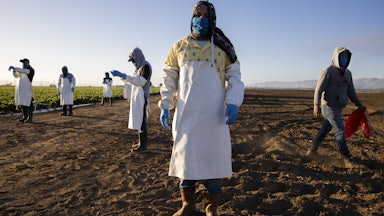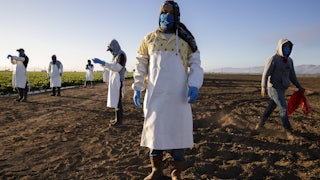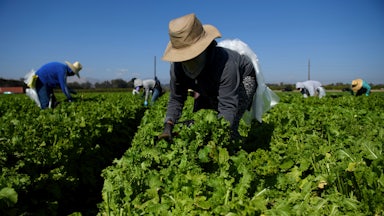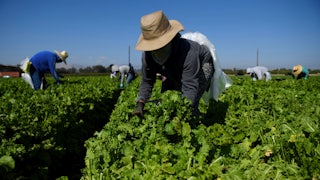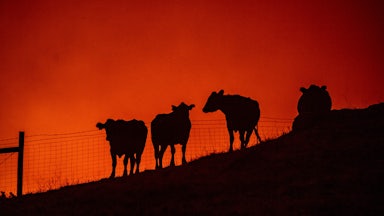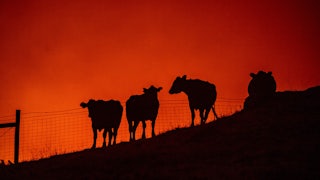This September, Guillermo Garcia embarked on a secular pilgrimage. Along with fellow United Farm Workers members, he began a 260-mile march to the California statehouse in support of a bill that would allow farmworkers to vote by mail in union elections, effectively making it easier for them to organize. As they walked, nonunionized laborers in the area caught wind of the march and started to join in. The difference in the working conditions they described was striking. “None of them,” Garcia recalled, “had paid holidays, none of them had days off.”
As the month waned, California Governor Gavin Newsom signed a host of pro-labor bills. It was an auspicious precursor to a month of labor strikes, walkouts, and aggressive contract negotiations around the country, including among autoworkers, cereal plant employees, health care providers, and film and television crews. But on September 22, Newsom announced that he had vetoed the farmworkers’ bill because of “various inconsistencies and procedural issues,” though the UFW claimed his office expressed no such reservations during the legislative process. The marchers felt betrayed. “We thought he would be on the side of farmworkers,” Garcia told me. “Farmworkers want to feed the nation,” he added, but are denied “the same rights that many, many American citizens have.”
Curiously, one of the Newsom administration’s rationales for the veto was that it did not “solve the damaging result” of a June Supreme Court decision that forbade organizers in California from entering farmers’ property to consult with workers, which NPR called a “potentially mortal blow” to the UFW. At a time of momentum for organized labor across the country, the situation for farmworkers’ unions appears comparatively bleak. Though field laborers in California produce two-thirds of the country’s vegetables, the UFW has shrunk to just a few thousand members, down from 70,000 during its heyday in the 1970s. There are around 1.3 million farmworkers in the United States, and fewer than 2 percent are unionized. (By comparison, there are only one-tenth the number of rural letter carriers in the U.S., and more of them belong to a union.)
These circumstances reflect both the historically marginal position of seasonal immigrant workers relative to the broader U.S. labor movement and the many ways that farmworkers are still shut out of labor protections nationwide, for reasons both old and new. Long-established barriers to collective bargaining have pushed many field laborers into creative forms of organizing. “Historically, workers have used a lot of different strategies and tools … it’s never been only unions,” said Dr. Gaspar Rivera-Salgado, a specialist in farmworker movements who serves as the UCLA Labor Center’s project director. “There’s no one single path to gain more rights.” Newsom’s veto serves as merely the latest reminder that, while the will to fight for better wages and more humane working conditions is fierce, farmworkers are all too often denied the basic legal infrastructure to support their quest.
In 1903, Japanese and Mexican workers in Oxnard, California, joined forces to demand better treatment from their employer. But when the incipient workers’ association wrote to the American Federation of Labor asking for recognition, the response didn’t exactly scream solidarity: The organization said it would accept the Mexican workers but not their Japanese counterparts.
“Labor has always struggled to decide what type of workers belong to the labor movement,” said Rivera-Salgado, and “has not always been open to organizing foreign-born and immigrant workers.” Sometimes, these groups have been directly at odds: The Agricultural Workers Organizing Committee, or AWOC, a UFW precursor, fought to end the Bracero Program, which brought seasonal laborers from Mexico to work in the fields in California for lower wages than locals.
Federal labor laws have historically evinced the same fault lines. In 1935, the landmark National Labor Relations Act shut out agricultural workers, many of whom were Black; the Fair Labor Standards Act, three years, later omitted them once again. “These workers were excluded from the great expansion of the U.S. economy,” Rivera-Salgado said. “It was left up to the states to basically manage these rights.”
Thanks to the sustained, aggressive organizing of Cesar Chavez and the UFW in the 1960s and ’70s, which led to the passage of the 1975 California Agricultural Labor Relations Act, California is one of very few states that officially recognizes the right of farmworkers to bargain collectively. Given the vexed history between farmworkers and organized labor, it is ironic that, in recent years, “labor in cities has been inspired by the militancy of the United Farm Workers,” Rivera-Salgado said. “And they’re turning to immigrants to increase their ranks.” But the UFW itself commands far less power than it did in its glory days—though there’s probably more need for its work than ever before.
Today, farm laborers in California and the Pacific Northwest toil on the front lines of the climate crisis, besieged by intolerable temperatures and wildfire smoke. If nonunionized workers speak up about the heat, Garcia said, the supervisor will tell them, “‘If you can’t put up with it, go home’—and they automatically don’t get called back the next day.” For undocumented members of the workforce, organizing carries huge risks. And more and more workers come to the U.S. on H2A seasonal visas, which are tied to an employer, meaning their presence in the country is entirely contingent on their ability and willingness to work fast and keep their mouths shut. In an echo of earlier conflicts between AWOC and the braceros, the Farm Labor Organizing Committee, which represents workers in North Carolina and the Midwest, is currently fighting to end the H2A program.
Growers lavish significant resources on union-busting, and it
pays off. Sarait Martinez, the executive director of the Fresno- and
Salinas-based Centro Binacional
para el Desarrollo Indígena Oaxaqueño, said there’s a lot of anti-union
sentiment among the farmworkers she knows. “My parents have had attempts to
organize where they work, but the employers contracted with people that came
and talked bad about the union,” she told me. “Those negative
perceptions just stay with people.”
All of this, Rivera-Salgado said, has contributed to “a sense of crisis” in the farmworkers’ movement. As its numbers have shrunk, the UFW has focused more on legislation, at times working alongside Centro Binacional and other workers’ rights organizations. But when California Attorney General Rob Bonta—whose farmworker parents organized alongside Chavez—came to Fresno in late October, Martinez and Eriberto Fernandez, the strategic campaigns coordinator for the UFW Foundation, both told him that labor laws go unenforced constantly, with little accountability.
Fernandez grew up working alongside his parents in the fields. Today, he said, though his parents are naturalized and don’t have to worry about getting deported if they speak up, “they still go through a lot. They call me every single day, like, this is going on. This is so unfair.”
Given the manifold attacks on farmworkers’ organizing rights—from individual growers and the agricultural lobby to state, federal, and judicial decisions—it’s hardly surprising that many field laborers seeking better working conditions have eschewed formal unions entirely. California has a strong tradition of wildcat strikes: workers walking off the job over pay and labor disputes, without union authorization or even union membership. This summer, berry pickers in Santa Maria, organized by Indigenous farmworkers’ organization MICOP, successfully staged a walkout. Fernandez called these strikes encouraging: “UFW see their membership not [just] in terms of how many dues-payers they have,” he said, noting that he works on legislation and cannot speak for the union arm of UFW. “I think Cesar Chavez had a much broader conception of what a union means.”
The Coalition of Immokalee Workers, in Florida, defines itself as a worker-led human rights organization. It targets retailers rather than growers, and has enjoyed some tremendous wins. “Instead of collective bargaining, they’re emphasizing corporate responsibility,” said Rivera-Salgado. Then there are organizations like Centro Binacional, which supports its workers through know-your-rights campaigns and assistance filing workplace claims but centers ethnic identity rather than labor solidarity. “Centro Binacional is Indigenous-led—everyone speaks the language and has an understanding of the community,” said Martinez.
Still, some independent unions have found success in recent years. Washington state’s Familias Unidas por la Justicia, which represents Indigenous berry pickers from Guerrero and Oaxaca, includes around 500 workers covered under a collective bargaining agreement, and an additional 500 that it supports, whose ranks include H2A visa-holders. The fight to organize began in Skagit County in 2013 after a worker was dismissed for asking for higher wages. “He got fired for saying something everybody was feeling,” said political director Edgar Franks. “Workers, by that point, were really tired of the abuses that were happening—not only at this farm but every farm they would work.” Familias Unidas was only recognized after a bitter three-and-a-half-year struggle. But they were able to establish a $15 minimum wage, “which, at the time, was unheard of for farmworkers,” said Franks, and even a health care fund that the employer, Sakuma Brothers Farm, pays into.
On October 13, 12 vineyard laborers on Long Island formed New York’s inaugural farmworkers’ union—a tiny but hopeful Striketober victory. The win was made possible by the state’s passage of the Farm Laborers Fair Labor Practices Act in 2019: more proof of just how piecemeal the fight to secure rights for farmworkers has been in the absence of federal protections. This year’s PRO Act would significantly expand federal recognition of the right to organize, paving the way for more unions like Familias Unidas and the Long Island example—but given the balance of power in D.C, its chances appear scant.
And even in California, at the heart of the farmworkers’ movement, the odds are stacked against them. When the news about Newsom’s veto came down while they were marching, Garcia said, the UFW workers changed course. Instead, they headed for the French Laundry, the exquisitely pricy Napa restaurant whose Michelin-endorsed delicacies had almost cost Newsom his job. The farmworkers chose the French Laundry to call attention to the hypocrisy of the governor, who had relied on Latino voters to reject the Republican bid to recall Newsom in September—Garcia personally made calls asking people to vote no—and touted the benefits of voting by mail, which UFW says is no different from the bill he rejected. But there was another, oblique layer of poignancy to their new destination. The French Laundry sources from its own garden, which supplies much of the restaurant’s produce, and a curated selection of small-batch “foragers.” As for the food nearly everywhere else: Farmworkers are the ones who picked those berries, harvested those mushrooms, unearthed those beets.
